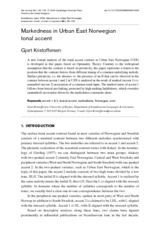Markedness in Urban East Norwegian tonal accent
Journal article
Permanent lenke
https://hdl.handle.net/1956/2401Utgivelsesdato
2006Metadata
Vis full innførselSamlinger
Originalversjon
https://doi.org/10.1017/s0332586506001508Sammendrag
A new formal analysis of the tonal accent contrast in Urban East Norwegian (UEN), is developed in this paper, based on Optimality Theory. In opposition to the widespread assumption that the contrast is based on privativity, this paper represents a return to the position that the contrast derives from different timing of a common underlying melody. Surface privativity, i.e. the absence vs. presence of an H, that can be observed in the contrast between accent 1 and 2 in Urban East Norwegian,, is analyzed as the result of marked (accent 1) vs. unmarked (accent 2) association of a common tonal input. The marked status of accent 1 follows from lexical pre-linking, protected by high-ranking faithfulness, which overrides (unmarked) association driven by the markedness constraints alone.
